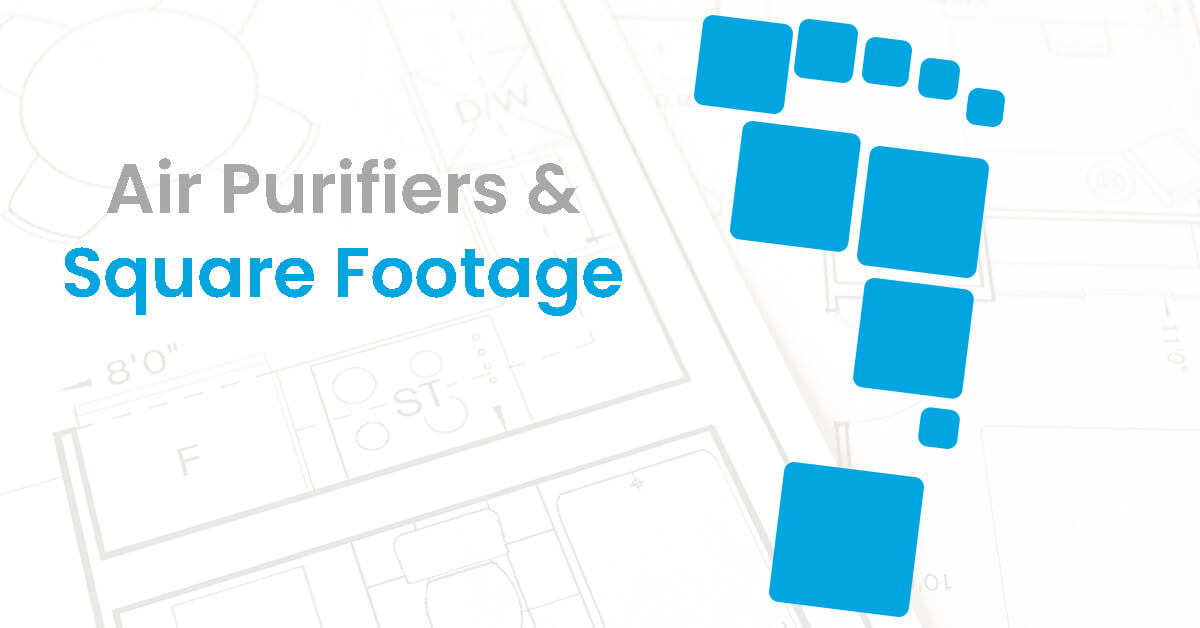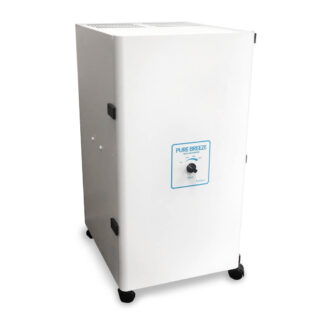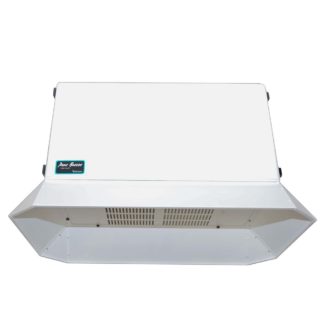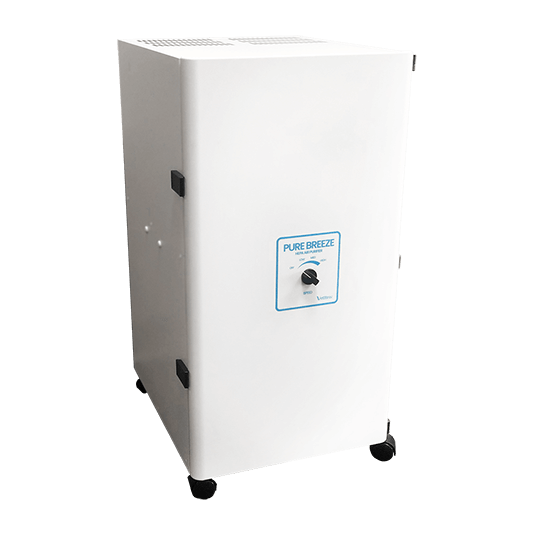
When it comes to portable in-room air purifiers, there’s a lot of information out there — not just from scientists, but from air purifier manufacturers as well…and of those manufacturers, not all market their products in good faith. Some of them capitalize on the confusion and add to it in order to sell more products.
We want to help clear up the confusion.
Right now, we’d simply like to help make sense of something we’ve seen in a lot of ads and product descriptions:
“Square footage.”
Perhaps you’ve seen that term a lot, too. As an example, you might see an air purifier ad boasting that it “cleans up to 1,000 square feet.”
…What does “square footage” even mean?
We think that’s supposed to give some idea of the size of room the purifier was designed for; unfortunately, it’s not particularly helpful. In theory, a small home air purifier and a medical grade air purifier could be said to clean the same amount of square feet.
Again, many marketers will happily keep things confusing, especially if most people don’t realize they’re being confused. “Square feet” is an easy and familiar metric to wrap our minds around. We all know what “square feet” means because we’ve all been through junior high math.
But if your goal is clean air, then the square footage of the room is only part of the equation.
The area of the room is not the same as the volume of the room, for one thing. Air is three-dimensional.
Also, you’ll need to consider the other factor besides space, which is of course time.
You need to start with a goal in mind
Imagine if every ten minutes, someone smoked a cigarette in the room. Would you want an air purifier to clean all the air in that space just once an hour? Or would you prefer if all the air were cleaned once every ten minutes?
If your goal is to not just to get the air clean, but to keep it clean, you have to consider how effectively your air purifier will clean a volume of air over time.
Volume, time, and the movement of air

What you need to look for is Air Changes per Hour (ACH), or more specifically for air cleaners, Clean Air Delivery Rate (CADR). CADR indicates the volume of filtered air that the air purifier delivers — the higher the CADR number, the faster the air in a room is cleaned.
Square footage on its own does not include time, and does not indicate CADR.
Sometimes you may see that an air purifier “cleans up to 1,000 sq. ft. every thirty minutes.” That’s a little better — you’ve got a time factor now. “Every thirty minutes” is twice an hour. Cleaning all the air two times an hour is your ACH.
The CADR is a measure of cubic feet per minute (CFM) moved through the filter. So, as you look for a product’s CADR, make sure you also understand what kind of filter the product uses. A HEPA filter is a very thick filter, and that means air is harder to move through it. But it’s the filter the CDC recommends using for indoor air purification.
Many manufacturers try to hide their products’ CFM or CADR. They know the power of the motor simply doesn’t hold up to the competition. Other products on the market may advertise strong motors for blowing air, but neglect to mention a poorer quality filter.
Something else to keep in mind when researching CADR or ACH of an air purifier: these metrics will vary depending on the size of the room. So too will the “square footage” metric that manufacturers advertise, depending on the unit’s motor and filtration system.
The secret metric most people forget about
It’s not really a secret, but it’s certainly something people become aware of as soon as they turn their unit on. We’re talking about sound.
How loud is the air purifier? Again, many manufacturers aim to obfuscate or hide the noise level their machines produce.
Decibels (dB) are measured on a logarithmic scale. 60 dB is twice as loud as 50 dB. (Trust us when we say the difference in noise is significant.)
As your dB level gets to the high 50s or into the 60s, the noise is likely going to disrupt what may otherwise be a quiet setting.
As you get up toward 70 dB, that’s like putting your ear close to a running vacuum cleaner.
Schools in particular should pay attention to this — classroom disruption often leads to frustration, and as a result, they may reduce the power or shut the unit off entirely. This can negate the whole point of getting air purifiers to begin with.
As a thought exercise: say you have a unit in a classroom with a CADR of 315 CFM on “High Speed” at 65 dB, and a CADR of 200 CFM on “Medium Speed” at 52 dB…Which speed setting do you think most teachers would prefer?
In other words, don’t opt for more power if it means more noise — in a practical sense, more noise will usually mean less power anyway.
Making the smartest decision
Here’s another really important thing we want to stress: not all rooms are equal.
Recommended ACH in a room for COVID-19 safety is 5-6 air changes per hour.
ACH is additive among HVAC and portable in-room air purifiers, so you’ll need to know the HVAC’s capabilities.
Different concentrations of people in the room will also make a difference; five people in a space produces a different risk than twenty people in that same space. Different settings will also have different noise level requirements.
Quick recap:
More than “square footage,” you need to consider:
- CADR — air volume over time
- HEPA filtration
- Noise
The best bet for making the smartest decision is to talk in depth with knowledgeable professionals. Don’t rely on what marketers put out there, and don’t rely on what’s newest or fanciest (which, as we covered in another post, can sometimes turn out quite badly).
If you’re in any sort of medical, commercial, or other high-traffic room (like a school classroom or government office), you really ought to consult with a product specialist from the manufacturing company you’re considering. The placement of the units in those rooms makes a difference, as does the filtration of the HVAC system in place, and a variety of other factors.
The Vaniman Pure Breeze HEPA Air Purifier
To be as clear and upfront as we can: Vaniman Manufacturing Co. manufactures a portable in-room HEPA air purifier. It comes with medical-grade HEPA filtration, a commercial grade motor, and advanced sound-dampening foam. Here are the metrics on our Pure Breeze:
- Unit CFM Rating — Pleated + HEPA Filter Configuration: 297 CFM (High)
- Unit CFM Rating — Two Additional Filters (Including Charcoal for Odors): 274 CFM (High)
- Sound (dB) @ 6 ft — 39 dB (Low), 49 dB (Medium), 56 dB (High)
- HEPA filter traps over 99.99% of air particles down to 0.3 micron
You can get a pretty good idea of how our units would perform by plugging these numbers and your room measurements into our free ACH calculator tool.
FREE DOWNLOAD: Complete Data & Features of the Vaniman Pure Breeze HEPA Air Purifier
But if you’re considering the Vaniman Pure Breeze HEPA Air Purifier as a solution for schools or dental offices or any other higher-risk setting, please contact us and speak with a product specialist. In addition to helping factor in your building’s ventilation and filtration, we can help determine placement and maintenance. We’ll always be honest and upfront about whether our product is right for you.
To order units online, see below:
-
 Pure Breeze HEPA Air Purifier – 10360A$1,926.86 – $2,055.86View Details
Pure Breeze HEPA Air Purifier – 10360A$1,926.86 – $2,055.86View Details -
 Pure Breeze HEPA Fume Hood – 10370$1,926.86View Details
Pure Breeze HEPA Fume Hood – 10370$1,926.86View Details
Click here to learn more about the entire Pure Breeze lineup of HEPA filtration units.
Sources:
Harvard-CU Boulder Portable Air Cleaner Calculator for Schools – https://docs.google.com/spreadsheets/d/1NEhk1IEdbEi_b3wa6gI_zNs8uBJjlSS-86d4b7bW098/edit#gid=1882881703
ASHRAE: Filtration/Disinfection – https://www.ashrae.org/technical-resources/filtration-disinfection
CDC: Ventilation in Buildings – https://www.cdc.gov/coronavirus/2019-ncov/community/ventilation.html

